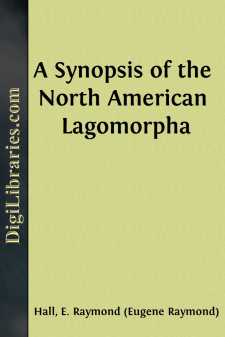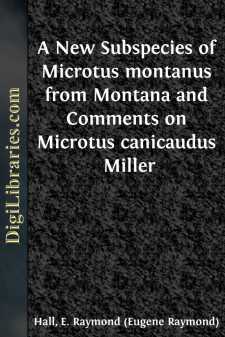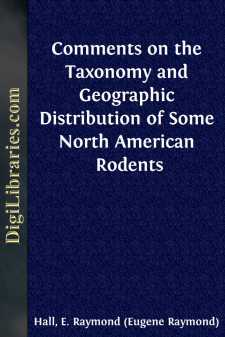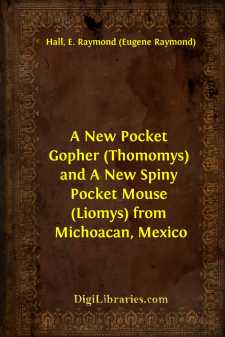Categories
- Antiques & Collectibles 13
- Architecture 36
- Art 48
- Bibles 22
- Biography & Autobiography 813
- Body, Mind & Spirit 142
- Business & Economics 28
- Children's Books 16
- Children's Fiction 13
- Computers 4
- Cooking 94
- Crafts & Hobbies 4
- Drama 346
- Education 46
- Family & Relationships 57
- Fiction 11829
- Games 19
- Gardening 17
- Health & Fitness 34
- History 1377
- House & Home 1
- Humor 147
- Juvenile Fiction 1873
- Juvenile Nonfiction 202
- Language Arts & Disciplines 88
- Law 16
- Literary Collections 686
- Literary Criticism 179
- Mathematics 13
- Medical 41
- Music 40
- Nature 179
- Non-Classifiable 1768
- Performing Arts 7
- Periodicals 1453
- Philosophy 64
- Photography 2
- Poetry 896
- Political Science 203
- Psychology 42
- Reference 154
- Religion 513
- Science 126
- Self-Help 84
- Social Science 81
- Sports & Recreation 34
- Study Aids 3
- Technology & Engineering 59
- Transportation 23
- Travel 463
- True Crime 29
Two New Meadow Mice from Michoacan Mexico
Description:
Excerpt
In preparing a list of kinds of mammals of which specimens have been saved from the Méxican state of Michoacán, two heretofore unrecognized subspecies of the Méxican meadow mouse, Microtus mexicanus, have been found. Names for these and descriptions are given below.
Microtus mexicanus fundatus new subspecies
Type.—Male, adult, skin and skull; No. 100637, Univ. California Mus. Vert. Zool.; 3½ mi. S Pátzcuaro, 7,900 ft., Michoacán, México; March 9, 1943; obtained by E. R. Hall, original no. 5882.
Range.—Known only from the vicinity of the type locality.
Diagnosis.—Size large (see measurements); color brown overlain with cinnamon; nasals expanded distally with premaxillary borders concave laterally; posterior border of orbit inclined posterolaterally; preorbital region and interparietal region depressed; incisive foramina narrow; zygomatic arches parallel; tympanic bullae much inflated.
Comparisons.—Among named subspecies of Microtus mexicanus, M. m. fundatus most closely resembles M. m. mexicanus but differs as follows: Larger in all parts measured; pelage with slightly less buffy color and with the buffy color that is present of a slightly lighter tint; posterior two-thirds of premaxillary border of each nasal concave rather than straight; posterior border of orbit forming more acute angle with sagittal plane of posterior part of skull; superior outline of nasals straight rather than depressed in posterior part; tympanic bullae more inflated both in vertical and horizontal planes.
From M. c. salvus, the subspecies next to the westward, fundatus differs as follows: Averaging larger in all parts measured; less reddish on upper parts; underparts with more reddish color but the reddish of lighter tint; perineal region buffy instead of plumbeous; nasals with premaxillary borders laterally concave rather than straight; superior outline of skull with nasal segment sloping anteroventrally and interparietal segment sloping posteroventrally rather than straight; posterior margin of orbit inclined posterolaterally thus forming an acute angle, instead of a right angle, with sagittal plane of braincase; zygomatic arches parallel rather than bowed outward; incisive foramina narrower; tympanic bullae more inflated in vertical plane.
Relying on Bailey's (N. Amer. Fauna, 17:55, 1900) description of Microtus fulviventer, fundatus differs in much larger tympanic bullae.
Remarks.—The series of 59 specimens includes individuals of several ages of both sexes. This has been a great advantage in making comparisons with individuals of geographically adjoining subspecies since individuals of the same age and sex could be compared. When the skulls are laid top-side down on a flat surface the occiput is much higher than in salvus.
Our specimens, taken in the dry season, were trapped mostly in runways beneath a dense growth of grass underneath a rail fence.
Specimens examined.—Total, 59, distributed, with respect to the town of Pátzcuaro, as follows: 3½ mi. S, 7,900 ft., 9; 4 mi. S, 7,800 ft., 16; 5 mi. S, 7,800 ft., 26; 9 mi. SE, 8,000 ft., 8.
Microtus mexicanus salvus new subspecies
Type.—Female, adult, skin and skull; No. 52099, Chicago Natural History Museum; Mount Tancitaro, 11,400 ft., Michoacán, México; July 19, 1941; obtained by F....












